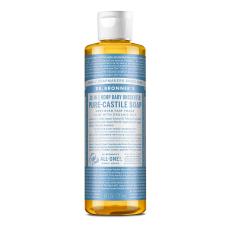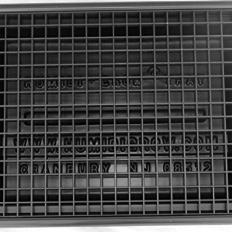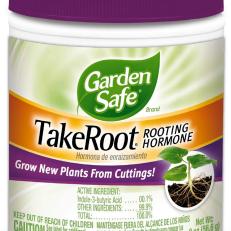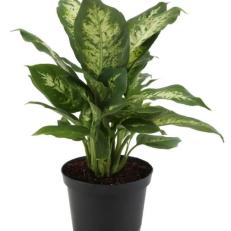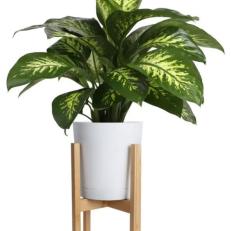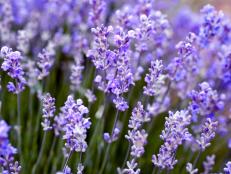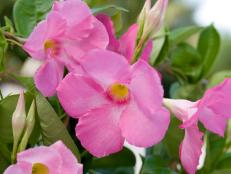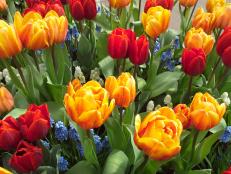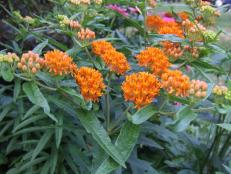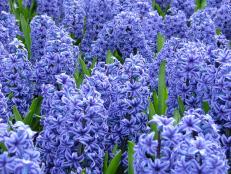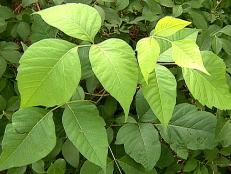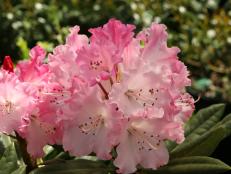Dieffenbachia: Planting and Care for Dumb Cane Plant
Lush tropical leaves and an easy-care personality make dieffenbachia a go-to houseplant for indoor color.
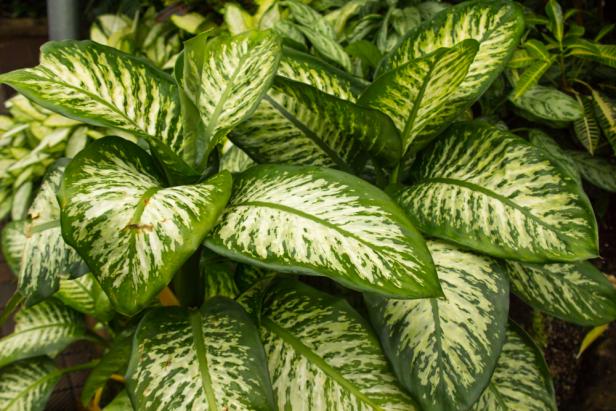
Shutterstock/lennystan
Varieties of tropical houseplant diffenbachia unfurl variegated leaves that add drama to indoor settings.
The best houseplants bring the most benefits in a low-maintenance package. Dieffenbachia (Dieffenbachia seguine) definitely fits that description, delivering terrific tropical color in a plant that’s easy to grow. Also known as dumb cane, dieffenbachia unfurls eye-catching variegated leaves decorated with stripes, spots or colored veins in shades of green, yellow, white or cream.
Dumb cane plant first received rave reviews during the Victorian era, and it continues to earn its keep in homes over a century later. That’s a clue to how easy dumb cane care is. Only plants with fuss-free, undemanding personalities stay popular that long.
Native to Central and South America, dieffenbachia is grown for its lush leaves, which bring a touch of the tropics to indoor settings. Gardeners prize this houseplant for its variegated leaves, not flowers, and also for its ability to purify indoor air. One average size dumb cane plant in a 6-inch pot purifies the air 100 feet around it, removing harmful volatile organic compounds (VOCs). Use dieffenbachia as a tabletop plant, or count on larger specimens to add drama beside a piece of furniture or against a blank wall.
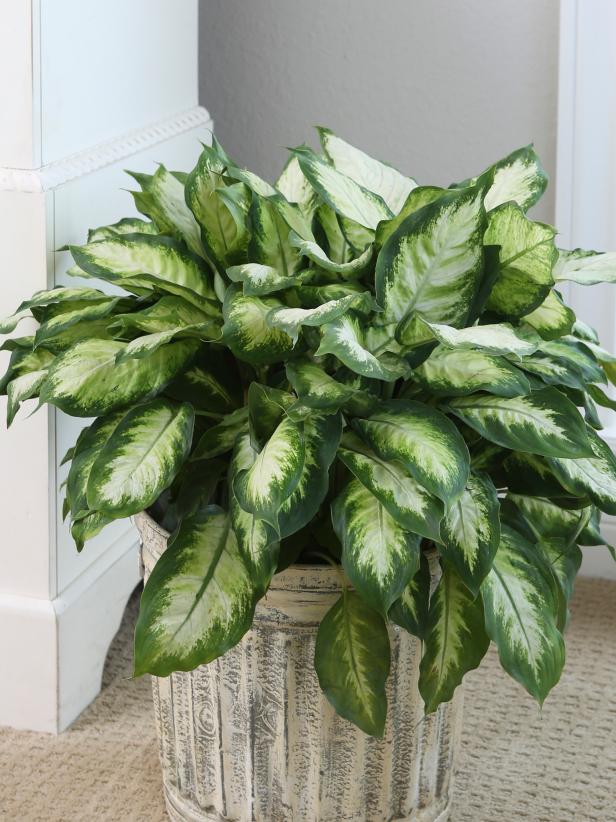
Costa Farms
Dieffenbachia is favored for its lush, variegated leaves.
Why It’s Called Dumb Cane
All parts of dieffenbachia — leaves, stems, roots — contain needle-like crystals called raphides. Consuming these crystals causes numbing, burning and swelling in the mouth and throat, which temporarily removes the ability to talk. That’s why it’s called dumb cane. For some people, dumb cane plant sap also causes a rash. Before adding this plant to your collection, consider the potential danger to children or pets. You can learn more about the poisonous effects of dumb cane at the National Capital Poison Center.
Dieffenbachia Light Needs
Dumb cane plants grow best in bright, filtered light during the majority of the year (spring, summer and fall) and tolerate full direct sun during winter. Dieffenbachia tolerates low light, including fluorescent light like in an office setting, but plants grow more slowly. Rotate dieffenbachia plants weekly, giving plants a quarter to half turn to keep stems from leaning toward the sunlight.
Watering Dieffenbachia
Dieffenbachia’s native habitat is tropical, where daily rains keep soil consistently moist. In a pot in your home, you want to water enough to keep the soil lightly moist, but definitely not soggy. The exception to this is if you’re growing dumb cane plant in low light. In that case, the plant grows slower, and soil will dry out more slowly. Allow soil to just begin to dry out before watering a dieffenbachia growing in low light. If you tend to overwater plants, let the top inch or two of soil become dry to the touch. When the soil dries out too much, leaves will wilt dramatically.
Other Care Tips for Dieffenbachia
- Temperature. This houseplant hails from a warm environment, so in the home aim to give it temperatures in the 60 to 75 degree range.
- Relative humidity. Dieffenbachia craves high humidity. Place it in a bathroom or other space where humidity is naturally higher to help meet these needs. You can also set dieffenbachia pots on a humidity tray — a pebble-filled tray of water. As the water evaporates from the tray, it raises the humidity around the plant. Keep the water below the bottom edge of the pot — you don’t want the plant’s roots sitting in water.
- Cleaning. Remove dust from leaves with a soft cloth, microfiber duster or cotton pad. If you notice a film or stubborn dust on your leaves, add a drop of castile soap to a bowl of water, dip your cloth or cotton pad into the solution and wipe the leaves two or three times, moving in the same direction. Do not use the same cloth to wipe different plants or you might transfer pests or disease spores from plant to plant. Avoid using commercial leaf shine products.
- Remove dead leaves. Clip or gently tug away lower leaves that turn brown. Always remove any dead leaves that fall onto the soil.
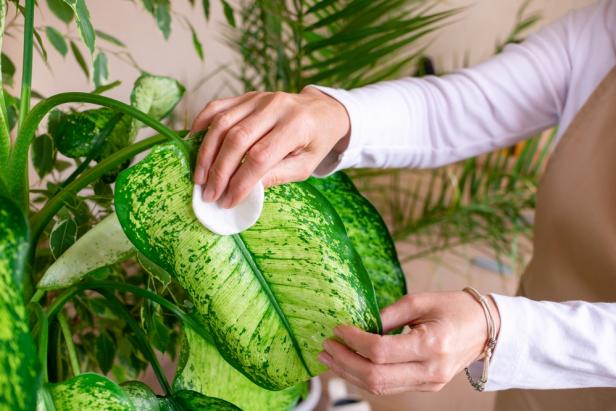
Shutterstock/Marys Poly
Clean diffenbachia leaves with a cotton pad or soft cloth. Wipe leaves in one direction only. Do not use leaf shine products.
Feeding Dieffenbachia
Fertilizing dumb cane plant causes it to grow faster and produce more leaves. You can feed plants monthly with a diluted houseplant fertilizer that you mix with water, such as Espoma’s indoor organic plant food or Jack’s Classic balanced plant food where the three numbers read the same, like 20-20-20. Reduce fertilizer during winter months when plant growth slows, especially in northern zones. If plants don’t have enough fertilizer, leaves will become smaller and stunted.
Buy Growing Supplies
Pruning Dieffenbachia
Lower leaves on plant stems (also called canes) turn brown as they age. Gently tug these free or snip to remove them. As dumb cane plants mature, stems may become too tall and bare looking, resembling tree trunks. Rejuvenate plants by cutting stems back to 6 inches tall. New growth will appear along the cane and around the base of the trunk. Root the top portion of the plant you cut off by removing lower leaves, dipping the base in a powdered rooting hormone (like Garden Safe brand) and sticking it into a small pot of soil on a root zone heating mat. You can also try to root the top part of the stem in water.
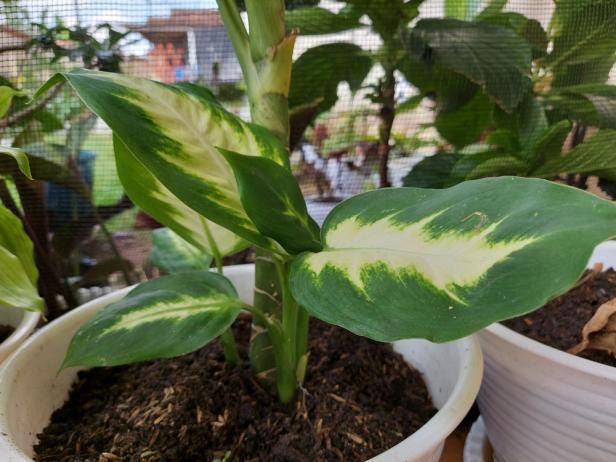
Shutterstock/Dyah kuswanto
Dieffenbachia stems will sprout new plants if you snip off the top of the main stem or cane.
Types of Dieffenbachia
Look for different types of dieffenbachia that feature various plant heights and assorted leaf colors, patterns, shapes and sizes. Some dieffenbachia plants are more upright, while others have a bushy growth pattern. These are a few of the most popular dumb cane plant varieties:
- Dieffenbachia ‘Tropic Snow’ — Dark green leaves blotched with creamy white along veins. Wide leaves tolerate lower light levels than most dieffenbachia. Grows 2 to 4 feet tall. (Dieffenbachia amoena ‘Tropic Snow’)
- Dieffenbachia ‘Camille’ — One of the most popular diffenbachia varieties. Creamy yellow leaves edged with rich green. Bushy growth to 2 to 3 feet tall. (Dieffenbachia maculata ‘Camille’)
- Dieffenbachia ‘Camo’ — Short for ‘Camouflage.’ Chartreuse leaves with erratic dark green specks and cream veins. Grows 3 to 4 feet tall. (Dieffenbachia ‘Camouflage’)
- Dieffenbachia ‘Compacta’—Cream-colored leaves are speckled and edged with bright green. Tends to grow really full with a bushy look. Indoors grows 1 to 3 feet tall. (Dieffenbachia ‘Compacta’)
- Dieffenbachia ‘Panther’ — Bushy, full plant features elongated green leaves with silver to creamy center veins. Grows 2 to 3 feet tall. (Dieffenbachia ‘Panther’)
- Dieffenbachia ‘Tiki’ — Upright variety tolerates low light levels. Silver leaves are mottled with green and white. Grows 3 to 5 feet tall. (Dieffenbachia ‘Tiki’)
Buy Dieffenbachia
Common Dieffenbachia Problems
- Brown leaf tips — Dieffenbachia develops brown leaf tips when humidity is too low. Raise humidity by grouping houseplants together, misting your dieffenbachia daily or setting pots on a humidity tray.
- Sticky leaves — Sticky leaves are a clue that your dieffenbachia has some kind of pest. Mealybugs, spider mites and aphids suck plant juices from leaves, which creates a sticky residue. Examine plants closely for pests and research treatments at your local garden center.
- Stalled growth — Dieffenbachia plants that aren’t growing most likely are not receiving enough light. Shift plants near a brighter window or add a plant light and see if growth improves.
- Wilting — Drooping leaves can mean one of two things. If soil is dry, wilting leaves mean you need to water. If soil is wet, wilting leaves indicate root rot has set in. Stop watering, repot in fresh soil and don’t overwater.
- Brown leaf edges — Too much fertilizer will turn leaf edges brown and crispy.
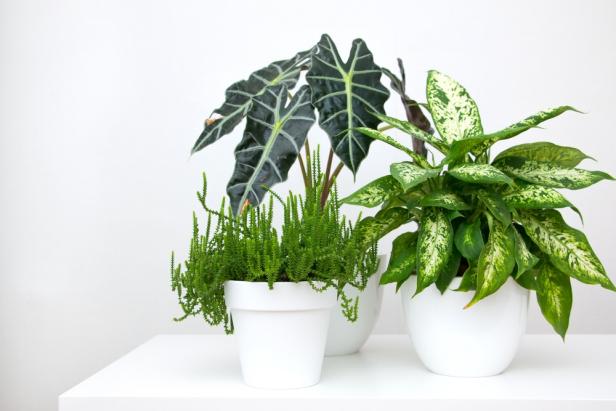
Shutterstock/Ekaterina_str
Tropical houseplants crave high humidity. One way to raise humidity is to group plants together. This trio includes alocasia and dieffenbachia (right).








